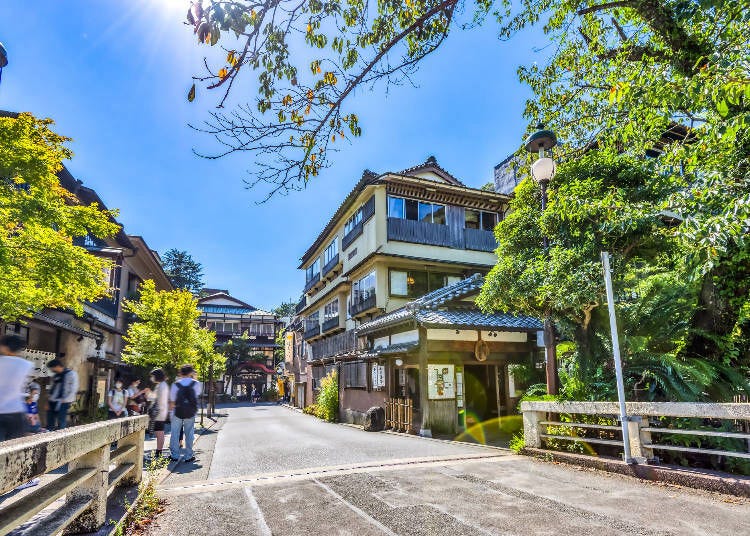
Where are the top tourist spots near Tokyo? There are many bucket list-worthy tourist spots and attractions just around 1-2 hours outside Tokyo that are perfect for a day trip! Here we’ll introduce the TOP 10 tourist spots near Tokyo with historical architecture and the unique natural beauty of rolling mountains and gorgeous waterfalls.
Main image: PIXTA
- Table of Contents
-
- 1. Nikko: Toshogu Shrine, Beautiful World Heritage Site
- 2. Kawagoe: A style town of the Edo period
- 3. Karuizawa: Tokyo’s Nearest Resort for Skiing and Shopping
- 4. Kamakura & Enoshima: A Refreshing Oceanside Place filled with History
- 5. Yokohama: Delicious Food, Historic Locations, and Unique Shopping
- 6. Hakone: Hot Springs, A Scenic Lake and Mountains
- 7. Chichibu: Shibazakura and Chichibu Night Festival
- 8. Hitachi-naka: Day Trips to Ibaraki’s Great Outdoors
- 9. Narita: Close to the Airport, Layover Tours, and More!
- 10. Makuhari: Concerts, Japanese Gardens, and Shopping
- A Day Trip Outside Tokyo: Now You’re Set Where to Go, What to Do!
First, we’ll start with Nikko, which houses an elaborate temple dedicated to Tokugawa’s first shogun, then Kawagoe which charmingly preserves old Tokyo. Plus, you can enjoy activities like skiing in Karuizawa, historical walks in Kamakura, Onsen hot springs in Hakone, and breathtaking displays of nature in Hitachi-naka. Finally, sightseeing aside, Yokohama, Makuhari, and Narita are prime dining and shopping opportunities.
1. Nikko: Toshogu Shrine, Beautiful World Heritage Site
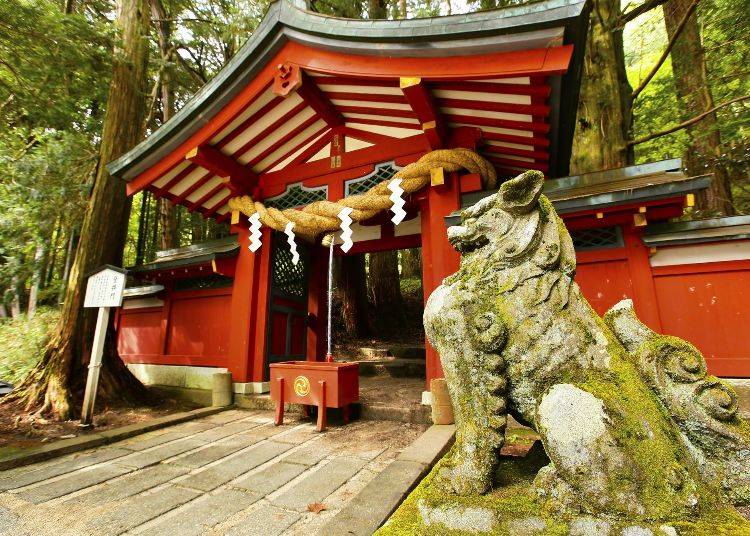
Nikko, home to the world-renowned Nikko Toshogu Shrine, is located just north of Tokyo in Tochigi Prefecture. It is an area full of beautiful natural scenery that’s stunning in every season. It is only about 2 hours by train from Tokyo, and you can enjoy being surrounded by ancient monuments, temples, and the comforting blanket of fresh air and refreshing nature.
Access to Nikko
From Tokyo Station, take the JR Tohoku Shinkansen to Utsunomiya Station (about 120min.) At Utsunomiya Station change to the JR Nikko Line to Nikko Station (about 40 min.) To Toshogu Shrine, take a bus from Nikko Station (5-10 minutes, depending on the route), and walk 5 min.
Nikko Toshogu Shrine
Nikko Toshogu Shrine is named in honor of Tokugawa Ieyasu, the first Shogun general in the Edo period. Its history goes back more than 400 years. In the Nikko Toshogu area, there are 55 national cultural treasures, including 8 national treasures and 34 important cultural properties. It is also registered as a World Heritage Site by UNESCO. It is definitely the first place not to be missed when visiting Nikko. An attraction you’ll remember forever.
There are 2 famous sculptures that you can’t miss among the many national treasures here. The most famous are the Three Wise Monkeys which are carved in the shapes of proverbial principles, “see no evil, hear no evil, speak no evil.” Another popular draw is the lifelike Sleeping Cat sculpture, it is an unusual figure for traditional Japanese architecture. Visitors often muse if the cat is truly sleeping, or merely pretending in order to nab the sparrows depicted nearby!
-

-
Address
2301, Sannai, Nikko-shi, Tochigi, 321-1431
View Map -
Nearest Station
Nikko Station (JR Nikko Line)
20 minutes on foot
- Phone Number 0288-54-0560
-
Address
2301, Sannai, Nikko-shi, Tochigi, 321-1431
Edo Wonderland Nikko Edomura
If you want to experience the magnificence of the Edo era in Japan 400 years ago, you must visit Edo Wonderland, Nikko Edomura! The streets of the Edo era are fully displayed in this expansive historical theme park, and there are many fun facilities and traditional performances to enjoy. Suppose you feel that it is not enough. In that case, you can also change into period clothes and enjoy playing the role of a period actor – ninja (kids only), samurai, princess, geisha, lord, or police officer, anything you choose!
Restaurants in Edomura serve Soba-noodle, Kushiyaki, other Japanese cuisines, and seasonal specialties. Snacking in the period town is also fun, with colorful sweet dumplings or shaved ice in the summer.
-

-
Address
470-2, Karakura, Nikko-shi, Tochigi, 321-2524
View Map -
Nearest Station
Kinugawa-Onsen Station (Tobu Kinugawa Line)
- Phone Number 0288-77-1777
-
Address
470-2, Karakura, Nikko-shi, Tochigi, 321-2524
Lake Chuzenji and Kegon Waterfall
Lake Chuzenji, a famous spot where you can enjoy the appearance of different seasons, is a beautiful lake formed by a volcanic eruption 20,000 years ago. It is also the highest lake in Japan. There are leisure facilities around the lake and different activities to enjoy, such as kayaking or taking the sightseeing ferry around the lake. With Akechidaira Ropeway, you can enjoy the natural beauty of all seasons from the sky-view.
Part of Lake Chuzenji is Kegon Waterfall, which was considered one of the “Eight Views“ that best show Japan back in 1927. The main falls have a height of 97 meters and are surrounded by lush nature. The most popular time to visit is in the fall when the leaves turn orange, red, and yellow, making the scene look like a place from a fairytale. You can view the falls from the top for a small fee to take an elevator down for a closer view.
-

-
Address
Chuguushi, Nikko-shi, Tochigi, 321-1661
View Map -
Nearest Station
Nikko Station (JR Nikko Line)
-
Address
Chuguushi, Nikko-shi, Tochigi, 321-1661
2. Kawagoe: A style town of the Edo period
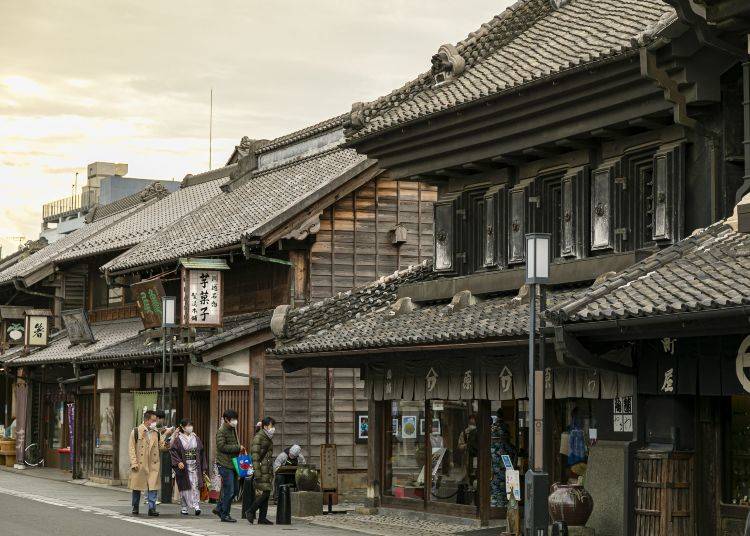
Located north of Tokyo in Saitama Prefecture, Kawagoe can be reached in about half an hour from Tokyo, making it a great day-trip destination. Kawagoe retains a lot of cultural monuments and buildings from the Edo period (1603-1868) and is full of strong Edo charm. The unique landscape formed by modern buildings co-existing with preserved treasures is incredible, and there are many well-known old shops and foods in the area as well.
Access to Kawagoe
From Ikebukuro Station, take the Tobu Tojo Line to Kawagoe Station (About 60 min.).
Kimono Make-over at Taisho Roman Dori
In Kawagoe, it’s popular for visitors to dress up in kimonos to experience authentic Japanese culture. The most representative scene of Kawagoe is the Taisho Roman Dori, or street, along which old storehouse-like houses with black plaster walls and tiled roofs are situated. Many date back to the Edo period. There are many specialty shops, restaurants, and snack bars on the sides of the street and in the alleyways between the buildings. Take a selfie in a Kimono at Taisho Roman Dori!
Time Bell Tower (Toki no kane)
The Bell of Time (Toki no Kane) is also a very famous and popular landmark. This 16-meter-high bell tower was first built between 1627-1634 and has provided timekeeping services to residents for 400 years. Visitors and locals alike can hear the historical chimes four times a day – at 6 a.m., noon, 3 p.m., and 6 p.m.
This is one of the most photogenic spots in Kawagoe and taking a selfie on a rickshaw with this Bell tower will give you a gorgeous shot.
-

-
Address
15-7, Saiwaicho, Kawagoe-shi, Saitama, 350-8601
View Map -
Nearest Station
Hon-Kawagoe Station (Seibu Shinjuku Line)
15 minutes on foot
- Phone Number 049-224-6097
-
Address
15-7, Saiwaicho, Kawagoe-shi, Saitama, 350-8601
Kita-in Temple
Kita-in, a Buddhist temple, is another must-see historical building in the area. As it features the only remaining building of the original Edo Castle. This building was transported here by Shogun Tokugawa Iemitsu, and so it was saved from the earthquakes and bombings that destroyed the main building in Tokyo during the 1900s. Historical significance aside, this is also a famous Sakura, or cherry blossom, viewing place that attracts countless tourists to come to see the flowers every year when they are in bloom!
-

-
Address
1-20-1, Kosenbamachi, Kawagoe-shi, Saitama, 350-0036
View Map -
Nearest Station
Kawagoe Station (JR Kawagoe Line / Tobu Tojo Line)
20 minutes on foot
- Phone Number 049-222-0859
-
Address
1-20-1, Kosenbamachi, Kawagoe-shi, Saitama, 350-0036
Kawagoe Hikawa Shrine
If you want to pray for love, a happy marriage, or good relationships, the must-visit place is Kawagoe Hikawa Shrine, which is about 1500 years old. In Japan, there is an old saying that your fated lover is clinging to your little finger with a thin red line. Adorable wish-charms made with red string are available here to help you find your soulmate.
A tunnel of prayer boards (Ema) can be found here, filled with warm-hearted dedications. Feel free to buy and make your own, or simply walk through. Between July and early September is the season of wind chimes here, some 2,000 wind chimes are hung around the shrine. When the wind blows, the chimes sway and ring crisply and sweetly, the beautiful pictures and videos you take are sure to become precious memories (not to mention social media hits)!
-

-
Address
2-11-3 Miyashitamachi, Kawagoe City, Saitama Prefecture, 350-0052
View Map -
Nearest Station
Kawagoe Station (JR Kawagoe Line / Tobu Tojo Line)
10 minutes by bus
- Phone Number 049-224-0589
-
Address
2-11-3 Miyashitamachi, Kawagoe City, Saitama Prefecture, 350-0052
Candy Alley (Kashiya Yokocho)
Candy Alley (Kashiya Yokocho) is another street where you can buy candy and snacks. Kawagoe is famous for sweet potatoes, so keep an eye out for snacks made with this local specialty. Not only can you find cute and nostalgic sweets, but the many handmade treats in beautiful packaging are also perfect for bringing home as gifts.
There are a lot of food and snacks to choose from while walking the old street. Our food recommendation is the eel bowl (Unaju, in Japanese) found at century-old specialty shop Ogawa Kiku. It is made with carefully selected Japanese eel with fresh and fatty meat. The store’s seventh-generation secret eel sauce is incredibly appetizing as well! Finally, COEDO beer is brewed here in Kawagoe, so beer-lovers should be sure to try some.
-

-
Address
2, Motomachi, Kawagoe-shi, Saitama, 350-0062
View Map -
Nearest Station
Kawagoe Station (JR Kawagoe Line / Tobu Tojo Line)
-
Address
2, Motomachi, Kawagoe-shi, Saitama, 350-0062
3. Karuizawa: Tokyo’s Nearest Resort for Skiing and Shopping
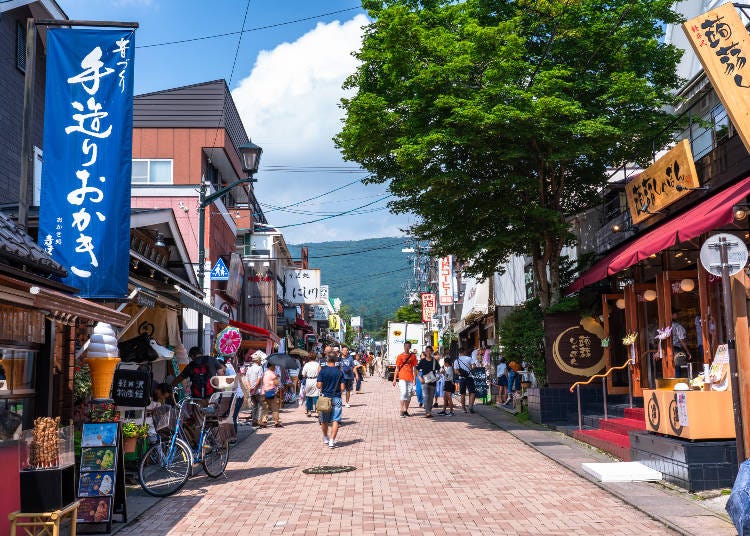
Karuizawa is a European-style resort that you can enjoy throughout the year. Located in the highlands and surrounded by verdant greenery, the area can still be cool and pleasant in the hot summer. In autumn it is filled with beautiful maple leaves, and in winter here you can find one of the closest ski resorts to Tokyo.
In 1886, a missionary from Canada, Alexander Croft Shaw, found that the natural beauty of Karuizawa was similar to his hometown. Shaw built a villa and began to introduce more people to the area. Since then, the area has been popular among foreigners, and over time Karuizawa was turned into a European-style resort.
Access to Karuizawa
From Tokyo Station, take the JR Hokuriku Shinkansen to Karuizawa Station (About 70 min.)
The Karuizawa Prince Hotel Ski Resort
Skiing is the most representative attraction in Karuizawa in winter. The Karuizawa Prince Hotel Ski Resort is one of the closest ski resorts to Tokyo and day ski trips using rental skis or snowboards are available here! There are several ski courses with different levels of difficulty so that adults and children alike can enjoy the joy of skiing together.
-

-
Address
389-0102 Karuizawa, Karuizawa-Machi, Kita-Saku-Gun, Nagano-Ken, 389-0102
View Map -
Nearest Station
Karuizawa Station (Hokuriku Shinkansen Line / Shinano Railway)
- Phone Number 0267-42-5588
Reserve a Lift ticket in advance
-
[EarlyDiscount] Lift ticket(2-Ticket Set)
- 1-Day Ticket
- Adult
- All-Day
View Deal15%OFF20,00017,000JPY
-
Address
389-0102 Karuizawa, Karuizawa-Machi, Kita-Saku-Gun, Nagano-Ken, 389-0102
▼Early-bird lift tickets are recommended for winter skiing in Japan▼
Karuizawa Prince Shopping Plaza Outlets
Karuizawa Prince Shopping Plaza outlet is loved very much by foreign tourists and is located just a few steps from the Karuizawa Prince Ski Resort. Only a 3-minute walk from the South Exit of JR Karuizawa Station to the shopping complex, there are more than 200 well-known brands and restaurants gathered here for your shopping enjoyment. It is also one of the most scenic outlets in the suburbs of Tokyo. The park and beautiful lakeside scenery make shopping here feel very comfortable indeed!
-
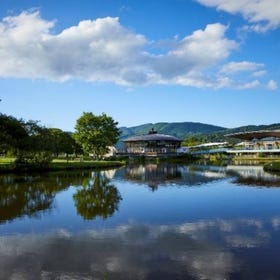 Karuizawa Prince Shopping Plaza軽井沢・プリンスショッピングプラザ
Karuizawa Prince Shopping Plaza軽井沢・プリンスショッピングプラザ- Address Karuizawa, Kitasaku District, Nagano 389-0102
Karuizawa Ginza Street
For souvenir shopping and small snacks, visit Karuizawa Ginza Street, Karuizawa’s version of Tokyo’s Ginza. This street is famous for its atmosphere of mixed western-Japanese architecture and a great place for a romantic stroll, or for photography fans, a scene ready for that perfect Instagram shot. You can rent cycles in this area and enjoy riding back and forth between the birch forest and the shopping district.
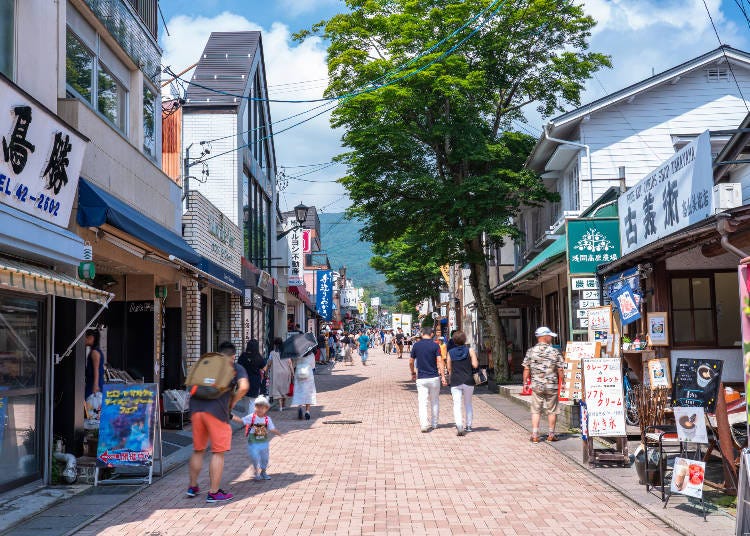
St. Paul Catholic Church
St. Paul Catholic Church is a wooden church built in 1935 by the architect Antonin Raymond, who studied under Frank Lloyd Wright and helped him with the Imperial Hotel construction project (actually, he was the one who completed the project instead of Wright). With a steeply angled roof, this church’s romantic and beautiful atmosphere attracts many couples who want to propose to each other or even hold their wedding here.
-
Karuizawa St. Paul's Catholic Church軽井沢聖パウロカトリック教会
- Address 179 Karuizawa, Kitasaku District, Nagano 389-0102
Kumoba Ike, Cloud-filled Pond
Kumoba, or the Cloud-filled Pond is listed as one of the must-visit places in Karuizawa. The calm and tranquil water of the lake will reflect the different hues of the surrounding forest and blue sky, it’s stunning in every season. There are lovely walking trails around the lake, as well as restaurants and cafes. Whether you’re looking to enjoy walking, cycling, or just dining with beautiful views, it is a very fun area to visit!
-
 Kumoba Pond雲場池
Kumoba Pond雲場池- Address Karuizawa, Kitasaku District, Nagano 389-0102
4. Kamakura & Enoshima: A Refreshing Oceanside Place filled with History
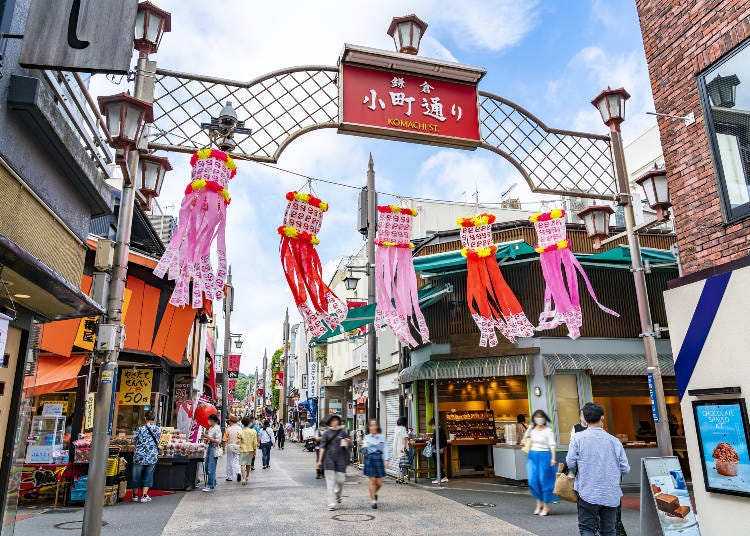
The Kamakura-Enoshima area, located in Kanagawa, should be high on the list of any day trip to the suburbs of Tokyo. It can be easily reached by train in about an hour from Tokyo, and it is splendid all year round, having countless sightseeing spots and facilities.
This area has a long history as one of Japan’s former ancient capitals, and here you can find various temples and shrines, and countless picturesque views. The coastline scenery, fun water activities, and vast assortment of snacks and foods are fun in any season. It’s a great area for all ages, and whether you’re solo, in a group, or with family, it has been a favorite destination for tourists. It is also the location of many Japanese dramas.
Access to Kamakura
From Tokyo Station, take the JR Yokosuka Line to Kamakura Station (About 60 min.)
Tsurugaoka Hachimangu Shrine
Tsurugaoka Hachimangu Shrine is Kamakura’s most important shrine. There are 2 parallel approaches to Tsurugaoka Hachimangu Shrine, Wakamiya-oji, meaning the Avenue of the young prince, and Komachi-dori, meaning Street of Beauty. Wakamiya-oji is a historic street built in 1182 to pray for the safe delivery of the Kamakura Shogun’s prince. Komachi-dori is a shopping street with lots of snacking opportunities. You can try Matcha soft-ice cream from Kamakura-chacha or takeaway sushi from Hannari-inari.
-

-
Address
2-1-31, Yukinoshita, Kamakura-shi, Kanagawa, 248-8588
View Map -
Nearest Station
Kamakura Station (JR Yokosuka Line / JR Shonan Shinjuku Line / Enoshima Electric Railway Line)
10 minutes on foot
- Phone Number 0467-22-0315
-
Address
2-1-31, Yukinoshita, Kamakura-shi, Kanagawa, 248-8588
Hydrangea Temple and Bamboo Temple
Meigetsuin Temple, also known as the Hydrangea Temple, is a must-visit spot for the rainy season (late June to early July in Japan). The ancient temple is full of tranquility on weekdays. During the annual rainy season, about 2500 hydrangeas bloom around the temple grounds.
On the other hand, Hokoku-ji Temple is known for its bamboo. Bamboo groves are known to muffle noise, and you can enjoy the tranquility and the bamboo leaves rustling in the wind.
Kamakura Daibutsu (Great Buddha of Kamakura)
Kamakura Daibutsu, or Great Buddha of Kamakura, was built in 1252. The height of the Buddha is 11.3m, and the total height including the pedestal is 13.3m, which is as tall as a 4-floor building. The weight is 121t, so even a big Tsunami in 1498 could not wash away this statue. The photoshoot with you and the Great Buddha will give you a memorable photo that you can show off to your friends for years.
-

-
Address
4-2-28, Hase, Kamakura-shi, Kanagawa, 248-0016
View Map -
Nearest Station
Hase Station (Enoshima Electric Railway Line)
7 minutes on foot
- Phone Number 0467-22-0703
-
Address
4-2-28, Hase, Kamakura-shi, Kanagawa, 248-0016
Enoden, Slam Dunk Scene in Real Life
If you are a railway fan and you want to enjoy the retro and nostalgic Enoden Line, there are 2 stations we recommend visiting. “Kamakura High School Stop” is featured in the manga Slam Dunk. At the level crossing near this station, you’ll see many tourists from around Asia who are looking for the perfect photo angle.
Don’t forget to take pictures of a beautiful sunset at Inamuraga-saki, the oldest surfing point in Japan. Hungry travelers will definitely fall in love with the rustic Café Yoridokoro; their menu is reasonably priced and filled with local specialties.
Enoshima Island’s Attractions
Enoshima is a small island that is accessible by bridge. The island also has facilities such as beaches, hot springs, an aquarium, observation decks, and beautiful scenery that transforms completely from day to night. The central point of the island is the Enoshima Shrine, which is dedicated to the goddess of the ocean, Benzaiten.
It is a steep upward climb to visit all of the shrines and reach the Enoshima Sea Candle, but there is an option to take a paid escalator! The observation deck of the Sea Candle gives you the chance to get the perfect sunset photos of Mt. Fuji, so have the cameras ready!
-

-
Address
2-3, Enoshima, Fujisawa-shi, Kanagawa, 251-0036
View Map -
Nearest Station
Katase-Enoshima Station (Odakyu Enoshima Line)
10 minutes on foot
-
Address
2-3, Enoshima, Fujisawa-shi, Kanagawa, 251-0036
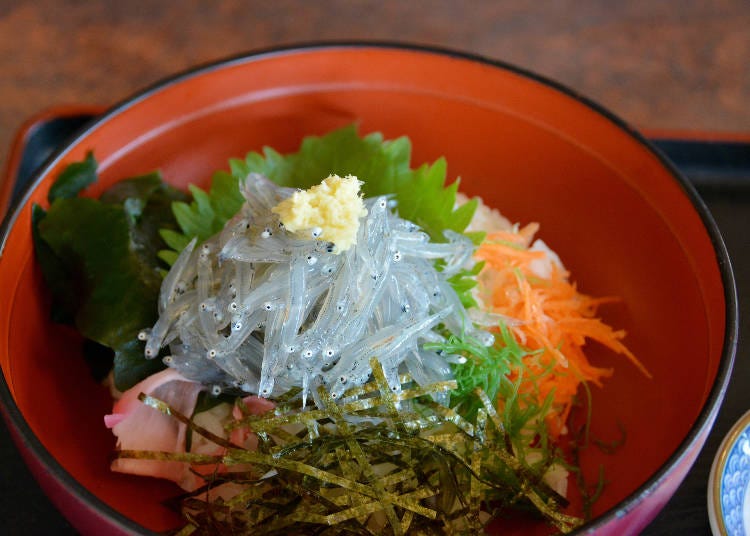
What to Eat in Enoshima
There are a lot of restaurants and cafes along the Kamakura coast. Among them, Il Chianti Beache and Amalfi Della Sera Kamakura restaurant offer excellent views of Enoshima, the ocean, and if you are very lucky, Mt. Fuji. When the weather is good, you can eat pizza and other delectable Italian dishes on the outdoor deck.
Enoshima is also famous for its seafood. The specialty is Shirasu, called Whitebait in English. Seafood bowls are popular, and many restaurants serve food prepared with Shirasu or bonito, a fish from the tuna family, and they are a must-try. For those squeamish about eating raw fish, they also have boiled bonito.
On the old streets near Enoshima Shrine, you’ll find a delicious snack - Takosenbei, or Octopus Cracker. It is also highly recommended to try! On an iron plate with a temperature of nearly 200 degrees, octopus is quickly pressed into crispy Japanese crackers. The senbei has a seductive aroma and a sweet and salty taste.
5. Yokohama: Delicious Food, Historic Locations, and Unique Shopping
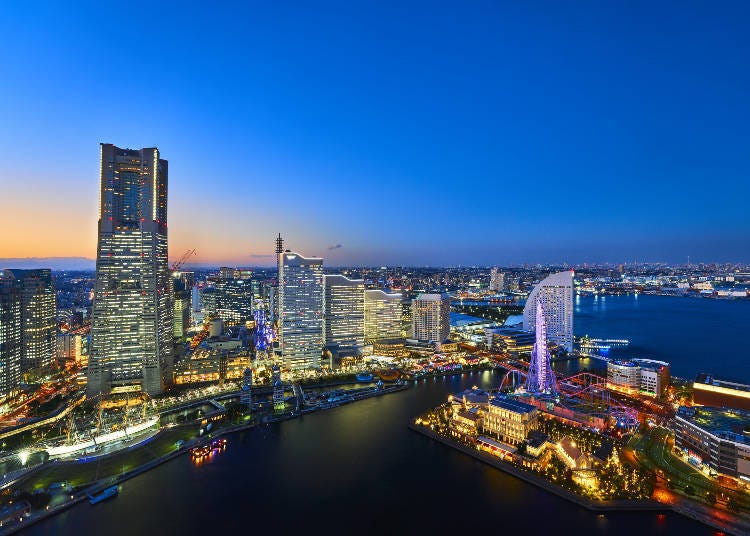
Yokohama is a famous tourist destination for many reasons. A place almost anyone will know is Yokohama Chinatown, a mecca of Chinese cuisine and architecture in the middle of a very Japanese city.
But Yokohama has far more to offer than its exciting Chinatown, from the shimmering nighttime views of neighborhood Minato Mirai to the rich history found in locations like the Red Brick Warehouse and attractions like the CupNoodles Museum, the options are endless.
Access to Yokohama
From Tokyo Station, take the Keihin Tohoku Line to Ishikawacho (Motomachi/Chukagai) Station (About 60 min.) For Yokohama Chinatown, get off the train and walk 10 min.
Stroll in Mouthwatering Smells from Chinatown
Of course, any visit to Yokohama should start with Chinatown. The moment visitors step through the huge, elaborately decorated gate, they are transported to a Chinese dreamscape – with bright red hues, hanging lanterns, and mouthwatering smells from every restaurant.
Though there is no shortage of restaurants, a good way to enjoy the atmosphere is by purchasing from street vendors – this will allow you to sample various cuisines in Yokohama Chinatown. A popular vendor of steamed buns is Edosei. Xiaolong Bao is another popular choice of food in Chinatown, though you may know them by their English name, Soup Dumplings. Adventurous eaters can try the Shark Fin Shaobin.
-

-
Address
Naka-ku, Yokohama-shi, Kanagawa, 231-0023
View Map -
Nearest Station
Motomachi-Chukagai Station (Minatomirai Line)
1 minute on foot
-
Address
Naka-ku, Yokohama-shi, Kanagawa, 231-0023
The Red Brick Warehouse
Once visitors have had their fill of local delicacies, they can move on to appreciating Yokohama’s culture and history. The Red Brick Warehouse is a building that makes an impression, due to not only its size but its contrast to the surrounding cityscape. There are two buildings that were constructed in 1911 and 1913. Due to the strength of their structure, they survived the Great Kanto Earthquake which devastated the surrounding area.
Today Building no.1 is used for cultural events, like art shows and exhibitions, while Building no. 2 has a shopping mall, restaurants, and a newly opened observation deck on the third floor.
-

-
Address
1-1, Shinkou, Naka-ku, Yokohama-shi, Kanagawa, 231-0001
View Map -
Nearest Station
Sakuragicho Station (JR Negishi Line / Line 3 (Yokohama Blue Line))
- Phone Number 045-211-1515
-
Address
1-1, Shinkou, Naka-ku, Yokohama-shi, Kanagawa, 231-0001
Minato Mirai Neighborhood
Yokohama evenings should be spent in the Minato Mirai neighborhood, which is famous for its night views and colorful Ferris wheel called Cosmo-clock 21. It’s a well-known “confession” spot, where people confess their love to their crush. Minato Mirai marks a shining and romantic end to a Yokohama day trip.
-

-
Address
Naka-ku, Yokohama-shi, Kanagawa, Nishi-ku, 220-0012
View Map -
Nearest Station
Yokohama Station (JR Tokaido Main Line / JR Yokosuka Line / JR Shonan Shinjuku Line / JR Keihin-Tohoku Line / JR Negishi Line / JR Ueno Tokyo Line / Line 3 (Yokohama Blue Line) / Tokyu Toyoko Line / Minatomirai Line / Keikyu Main Line / Sagami Railway Main Line)
-
Address
Naka-ku, Yokohama-shi, Kanagawa, Nishi-ku, 220-0012
Motomachi & Yamashita Park
Right next to Yokohama Chinatown is a local shopping street, Motomachi Shopping Street. High-quality clothes, shoes, and bags are available from Yokohama original brands. This shopping street is pet-friendly and there are pet-wear shops and pet-only water fountains. Bakeries in this street are serving freshly baked bread at reasonable prices.
Chilling at Yamashita Park after the foodie excitement is also recommended, where locals walk, talk, jog, and relax. There is also something extra-special walking through this park this year. GUNDAM FACTORY YOKOHAMA pops up in the bay area Until March 31, 2023, and you can see the real scale GUNDAM that is 18 meters-high and 25t, and strikes a different pose every 30 min.
-

-
Address
279, Yamashitacho, Naka-ku, Yokohama-shi, Kanagawa, 231-0023
View Map -
Nearest Station
Motomachi-Chukagai Station (Minatomirai Line)
3 minutes on foot
- Phone Number 045-671-3648
-
Address
279, Yamashitacho, Naka-ku, Yokohama-shi, Kanagawa, 231-0023
Gumyoji Temple
Gumyoji Temple, which is believed to have been founded in the year 721, is a respite from the Yokohama hustle and bustle. The temple features an 11-headed Kannon statue, who is the Goddess of Mercy. The statue can be touched by placing a hand on a wooden pillar in the courtyard which is attached to the statue by a cord. It’s a 30min. train ride by Keikyu-honsen from Yokohama station.
-
Gumyoji Temple弘明寺
- Address 267 Gumyojicho, Minami-ku, Yokohama, Kanagawa 232-0067
6. Hakone: Hot Springs, A Scenic Lake and Mountains
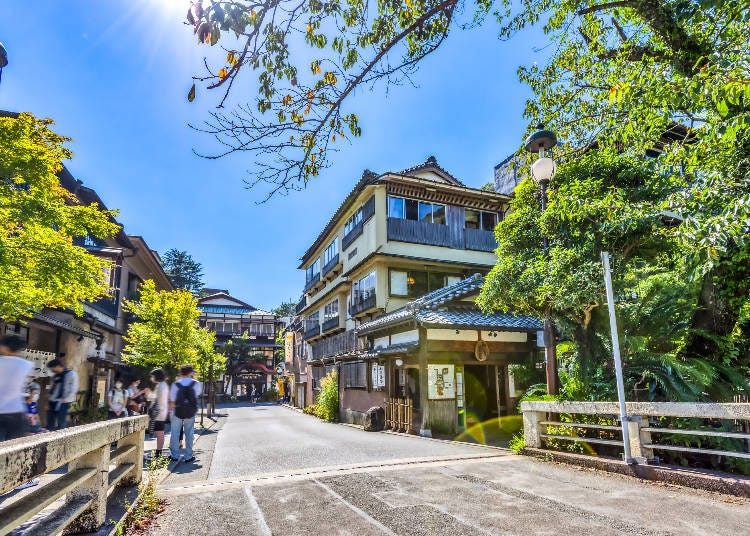
Hakone is a well-known Onsen hot springs resort about 1.5 hours from Tokyo. There are many attractions like Lake Ashinoko, Owakudani Valley, Hakone Shrine, and the Hakone Tozan Railway that connects the scenic spots. The Odakyu Romancecar express between Shinjuku and Hakone-yumoto station is the best choice to get there. The first carriage and the last carriage have special seats called tenbo-seki (view-seat) to enjoy the panoramic view.
Access to Hakone
From Shinjuku Station, take the Odakyu Romancecar to Hakone-Yumoto Station (About 110 min.)
Which Onsen to visit in Hakone?
Hakone has 5 main Onsen areas; Hakone-yumoto, Kowakudani, Gora, Moto-hakone, Sengokubara.
・Hakone-Yumoto, where the Odakyu Romancecar arrives, is a popular tourist spot, with many hotels and souvenir shops.
・Kowakudani is the location for luxury hotels, with good access to the hot spring theme park Yunessan and the Hakone Open-Air Museum. (Yunessan accepts guests with tattoos if they are covered with a bandage or rash guard.)
・Gora is where the Hakone Tozan Railway starts and is a hub to many sightseeing spots. Mountain railways, cable cars, and buses converge.
・Moto-Hakone is the eastern area of Lake Ashinoko, where historical sites like Hakone Shrine, Hakone Sekisho, or Hakone Checkpoint are located.
・Art lovers should not miss Sengokuhara, where museums such as Hakone Lalique Art Museum, Hakone Glass Forest, Prince of the Stars Museum, and Pola Museum of Art are all located. In Autumn Sengokuhara is famous for its views of silver grass fields.
Owakudani Valley and Black Eggs
Owakudani Valley is a crater created by the last eruption of Mount Hakone and located at an altitude of 800 - 1000 meters on the north side of Mt. Kammuriga-take. Taking the Hakone Ropeway from Soun-zan to Togendai is a fantastic experience, overlooking the majestic Hakone scenery of Owakudani and Ubako from higher up, it’s about a 30min. ride to enjoy all of the main sights of the area.
Kuro-Tamago are black eggs with the unique smell of this area’s sulfur springs. Don’t let the color and smell scare you! These are chicken eggs boiled in the sulfuric waters of Owakudani, and locals say that eating one will add 7 years to your life.
Since Owakudani is still an active fumarolic zone, the strong sulfuric smell and hot steam have a strong impact on tourists. Because of the gases in the area, people who have concerns with their heart or respiratory, pregnant women, babies, and the elderly are recommended to tour by car instead.
-

-
Address
1251, Sengokuhara, Hakone-machi, Ashigarashimo-gun, Kanagawa, 250-0631
View Map -
Nearest Station
Gora Station (Hakone Tozan Railway / Hakone Tozan Cable Car)
- Phone Number 0460-84-5201
-
Address
1251, Sengokuhara, Hakone-machi, Ashigarashimo-gun, Kanagawa, 250-0631
Pirate Boat and Hakone Shrine
If you want to enjoy the magnificent scenery of Hakone, come and take a fun Pirate Boat ride around and see Lake Ashinoko! Done in the shape of a real battleship from the 18th century, you’ll love the beautifully carved Hakone Lake Ashinoko sightseeing boat.
Cruising along Lake Ashinoko, you can admire Mount Fuji, the huge red torii that stands by the lake, and the Hakone Shrine. Following the red Torii-gate up from the lake, visitors can enjoy an upward climb through dense forests to reach the hidden heart of the shrine.
-

-
Address
80-1, Motohakone, Hakone-machi, Ashigarashimo-gun, Kanagawa, 250-0522
View Map -
Nearest Station
Hakone-Yumoto Station (Hakone Tozan Railway)
- Phone Number 0460-83-7123
-
Address
80-1, Motohakone, Hakone-machi, Ashigarashimo-gun, Kanagawa, 250-0522
7. Chichibu: Shibazakura and Chichibu Night Festival
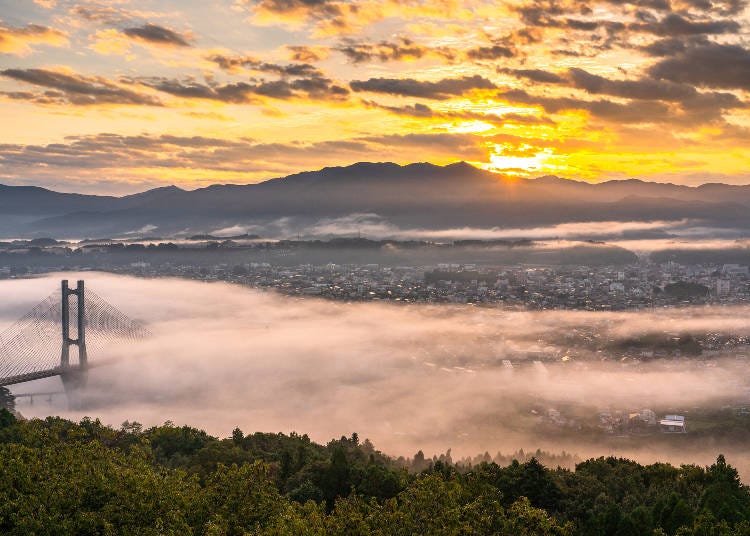
Chichibu is a city full of nature and history in Saitama prefecture. Though the cherry blossom season in Tokyo ends in early April you can continue the spring fun by planning a day trip north to Chichibu to enjoy the Shiba-zakura, meaning ‘lawn cherry blossoms’ in Japanese.
You can reach Chichibu in about 80min. via the Seibu Railway from Ikebukuro. There are many natural sights in the Chichibu region, it’s filled with lush green mountains and clear rivers. Chichibu also has a lot of outdoor activities in addition to relaxing hot springs.
Access to Chichibu
From Ikebukuro Station, take the Express train to Chichibu Station on the Seibu Ikebukuro Line (About 105min.)
Shibazakura Hill at Hitsujiyama Park
In the vast Hitsujiyama Park in the heart of Chichibu, a spectacular blanket of Shibazakura is planted. The colorful Shibazakura moss phlox is in full bloom every year from April to May. There are 9 types of Shibazakura, ranging from pink, and white to blue-purple. They are scattered around the hills and form a carpet of flowers. Shibazakura lingers a little while longer than Sakura. Tourists can enjoy seeing them for around one full month.
During the shibazakura season, Hitsujiyama Park holds the Shibazakura Festival, which gathers special food vendors called Yatai, selling delicious snacks, Chichibu local agricultural products, and handicrafts.
-

-
Address
6267, Omiya, Chichibu-shi, Saitama, 368-0023
View Map -
Nearest Station
Seibu-Chichibu Station (Seibu Chichibu Line)
15 minutes on foot
- Phone Number 0494-25-5209
-
Address
6267, Omiya, Chichibu-shi, Saitama, 368-0023
Chichibu Night Festival at Chichibu Shrine
In winter, the annual Chichibu Night Festival is even more popular. This festival is held every year on December 2nd to celebrate Chichibu Shrine and is one of the few grand fireworks festivals held during in winter in Japan. With a history of more than 300 years, it is considered on par with Kyoto’s Gion Festival and the Hida Takayama Festival and is listed as one of Japan’s three major float festivals.
Chichibu Shrine, said to have a history of more than 2,000 years, has been incense-filled since ancient times. The main shrine inside was reconstructed by Tokugawa Ieyasuin 1592 and has a strong Edo period architectural style. There are also many beautiful carved decorations by the same sculptors of Nikko Toshogu Shrine.
-

-
Address
Chichibu-shi, Saitama Banba 1-3, 368-0041
View Map -
Nearest Station
Chichibu Station (Chichibu Railway)
3 minutes on foot
- Phone Number 0494-22-0262
-
Address
Chichibu-shi, Saitama Banba 1-3, 368-0041
Nagatoro Line-Kudari Boating
For those seeking exciting outdoor activities, Chichibu has Nagatoro Line-kudari (boating). Nagatoro Valley is known for its beauty, and Line-kudari starts calmly in the scenic area then gets wild down at the rapids. Professionally trained boatmen will entertain you all along the way. Be sure to put your cameras and mobile phones in your backpacks.
Mitsumine Shrine, the Hidden Wolf Shrine
Mitsumine Shrine is the true hidden gem of Chichibu. Located at an altitude of 1,100 meters, this shrine is not an easy spot to get to. You need an hour-long bus ride on a winding road, with a huge dam and mountains on the way, but you’re guaranteed to be impressed when you get there - it’s said to be the birthplace of Japanese mountain asceticism. The wolf is worshiped as the God in this shrine. This Shrine is registered as a historical Geosite of Chichibu Geopark.
-

-
Address
298-1, Mitsumine, Chichibu-shi, Saitama, 369-1902
View Map -
Nearest Station
Kumagaya Station (Chichibu Railway)
- Phone Number 0494-55-0241
-
Address
298-1, Mitsumine, Chichibu-shi, Saitama, 369-1902
Comfortable Onsen Experience
There are also many natural hot springs in the Chichibu area. The most convenient one is the Onsen facility called Matsuri-no-Yu located next to Seibu Chichibu Station. Here, there are 2 kinds of baths with different spring qualities and curative effects. The local natural hot spring water from 2,000 meters underground, contains iodine, and has a relaxing effect. Here they also analyze the quality of hot springs in various locations and recreate hot spring water from all over Japan. Enjoy delicious local Chichibu foods like Udon, Miso-potato or Waraji-katsu afterward! (Visitors with tattoos are not accepted at this facility.)
8. Hitachi-naka: Day Trips to Ibaraki’s Great Outdoors
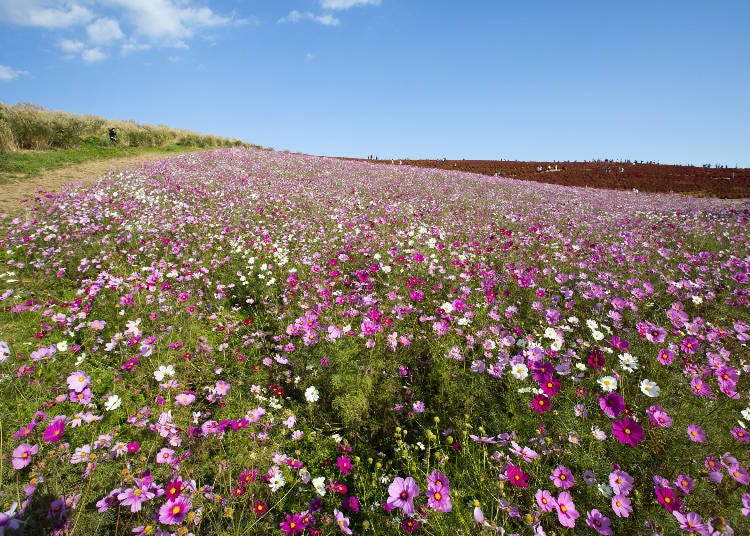
Hitachi-naka City in Ibaraki Prefecture is located on the Pacific coast and is a destination blessed with abundant nature. Hitachi Seaside Park is about 2 hours by train and bus from Tokyo Station (the nearest Station is JR Katsuta Station).
Access to Hitachinaka
From Tokyo Station, take the JR Joban Line Limited Express to Katsuta Station (About 90 min.) To National Hitachi Seaside Park, take a bus for about 15 min, and walk 10 min.
Gorgeous Seasonal Flowers at Hitachi Seaside Park
Hitachi Seaside Park is renowned for its variety of beautiful flowers throughout the year. There are daffodils, tulips, and canola in spring; lavender, sunflowers, roses, and green Kochia (also called “broom-grass”) in summer; and cosmos and vivid crimson Kochia in autumn. The park has an amusement park, sports plaza, bike trail, golf course, and a BBQ plaza. It is pretty for bringing family or friends here for a pleasant leisure time!
Among all of these attractions, the large and picturesque flower field of nemophila (baby blue eyes) should immediately come to mind. Known as “the gorgeous blue flower field in Japan” in recent years, it has been designated by countless tourists as a must-visit spot to see the magnificent scenery in person. Nemophila bloom in the middle of April to early May each year, with about 5.3 million blue nemophila flowers.
In addition to walking tours, the park also provides different ways to explore; you can tak
-

-
Address
605-4, Onuma, Mawatari, Hitachinaka-shi, Ibaraki, 312-0012
View Map -
Nearest Station
Katsuta Station (JR Joban Line / Hitachinaka Seaside Railway Minato Line)
-
Address
605-4, Onuma, Mawatari, Hitachinaka-shi, Ibaraki, 312-0012
Mito Kairakuen Garden
With another 1-hour train ride from Hitachi Seaside Park, you can visit Mito Kairakuen Garden, which is renowned as one of the 3 most beautiful Japanese gardens. Kairakuen’s name comes from a passage in The Book of Mencius, a classic work by a Chinese philosopher, stating that “people in ancient times enjoyed themselves together with all kinds of people, and therefore enjoyed themselves well.” At the time, these spaces were mostly for the upper classes, but based on the philosophy of the passage, Mito Kairakuen Garden was opened to the common people as well.
The garden features beautiful scenery in all seasons of the year but is especially renowned for its Ume (plum) blossoms.
-
Kairakuen Garden偕楽園
- Address 1-1251 Migawa, Mito, Ibaraki, 310-0912
2 More Adventures: Fukuroda Falls and Ryujin Ohashi Bungee
With a 1-hour drive by car you can enjoy visiting Fukuroda Falls or one of the largest bungees in Japan at Ryujin Ohashi, a huge Suspension Bridge.
Fukuroda Falls
Fukuroda Falls is a stunning 4-tier waterfall with a height of 120 meters at the tallest point. Surrounded by natural beauty, it is easy to see why this waterfall is rated as one of the top 3 most beautiful waterfalls in Japan. If you visit in the winter, you could be one of the lucky few to catch a glimpse of an icy, glittering, frozen waterfall.
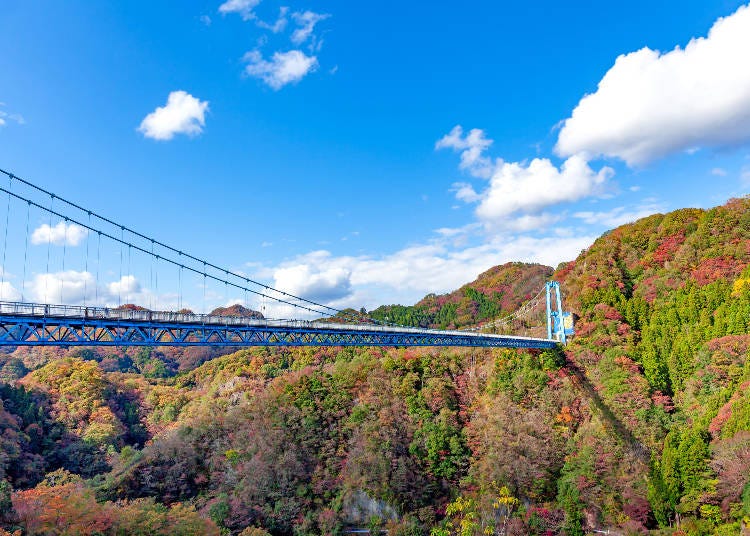
Ryujinkyo Gorge Bungy
Ryujin Otsuribashi is one of Japan’s longest suspension bridges, 100 meters above Ryujinkyo Gorge. Thrill seekers can ask for the mercy of the Dragon God (that’s what Ryujin means) by trying the Ryujin Bungy. Those who aren’t up to the jump can still pay a small fee to take a peek off the jumping platform to marvel at the distance. It’s perfect for those who love adventure and the outdoors.
9. Narita: Close to the Airport, Layover Tours, and More!
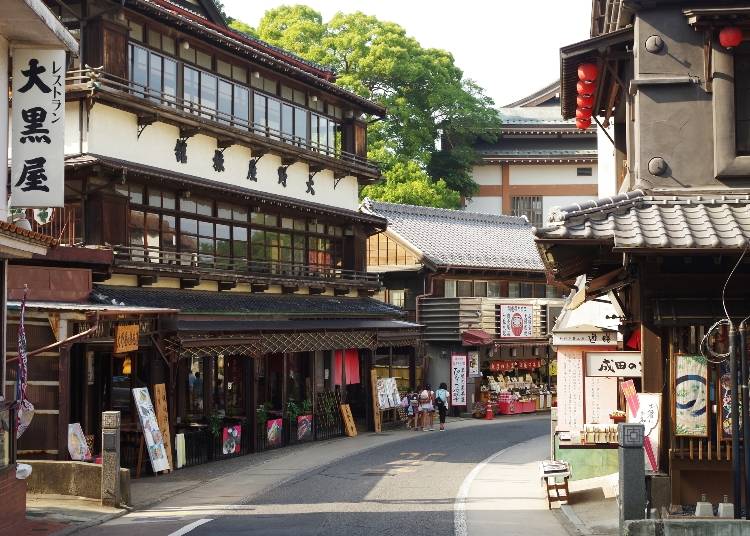
Narita City, which includes Narita Airport, is well-known as an international travel hub that connects Tokyo with the larger world. Featuring ancient temples, nearby historical towns, it is a perfect place for visitors to Japan who are short on time, possibly with a long layover, or searching for attractions close to Tokyo.
Access to Narita
From Nippori Station, take the Keisei Line to Narita Station (About 70 min.) To Naritasan Shinshoji Temple, walk 10-15 min.
Naritasan Shinshoji Temple Complex
Naritasan Shinshoji Temple dates back to the year 940 and features a variety of examples of Japanese architecture, like the Great Pagoda of Peace, done in the Tahoto style, which always has an even number of stories, unlike the usual 3-story Pagoda (Shinshoji Temple has 3-story Pagoda, too). The temple is centered around a principal sacred object Fudo-Myo-o which is rumored to have been carved by the founder of the Shingon sect of Buddhism himself, Kobo Daishi.
Once visitors have thoroughly appreciated the dignity of the temple, they will find themselves delighted by Naritasan-Omotesando, the store-lined approach to the temple. This is a typical Japanese shopping street, sloping up to the temple and decorated with flags and lanterns. Visitors can enjoy Japanese snacks and shop for crafts that have been made in this area for centuries.
-

-
Address
1, Narita, Narita-shi, Chiba, 286-0023
View Map -
Nearest Station
Narita Station (JR Narita Line)
10 minutes on foot
- Phone Number 0476-22-2111
-
Address
1, Narita, Narita-shi, Chiba, 286-0023
Historical Town Sawara
Though not part of Narita City, the small town of Sawara is highly recommended when visiting the area. The town is centered around its canal, and the shops and residences that line it are either original or restored buildings from the Edo period (1603-1868).
Visitors who are lucky enough to come in July or October can experience the Sawara Grand Festival. This festival has been registered as an Intangible Cultural Heritage by UNESCO. Numerous dolls representing Japanese legends are paraded through the streets in a breathtaking cultural display. Some of these dolls can still be viewed even if the festival is missed, by visiting the Suigo-Sawara Dashi Kaikan Museum.
-
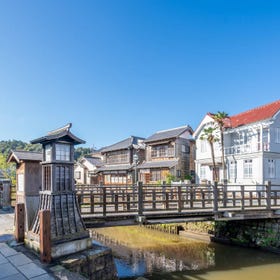 Historical Town Sawara佐原町
Historical Town Sawara佐原町- Address I-1903-1, Katori, Chiba 287-0003
Boso-no-Mura, Chiba Prefectural Open-air Museum
For an alternative historical adventure, Chiba Prefectural Boso-no-Mura is a theme park near Narita Airport with plenty of opportunities to get some hands-on experience with traditional Japanese crafts. This museum is huge, with plenty of different areas and eras to explore, from prehistoric to near-modern Japan.
Fudoki-no-Oka is an 82-acre zone highlighting nature and history. Here it’s possible to view burial mounds and an authentic (though relocated) farmhouse built in the late 18th century. Furusato-no-Waza (Hometown Arts and Crafts) is a long traditional street featuring recreated houses of merchants, a blacksmith, a tatami mat shop and so on.
Here visitors can create really unique souvenirs, like Japanese pottery, or Magatama, pendants representing Yin and Yang. Apart from that, it’s also possible to learn the etiquette for a tea ceremony, wear armor, or enjoy a ride on a Japanese boat pushed by a boatman.
-
Boso-no-Mura千葉県立房総のむら
- Address 1028 Ryukakuji, Sakae, Imba District, Chiba 270-1506
AEON MALL Narita and Shisui Premium Outlets

AEON MALL Narita and Shisui Premium Outlets are for those who need to do some last-minute shopping, as both are about 15 min. by bus from Narita Airport.
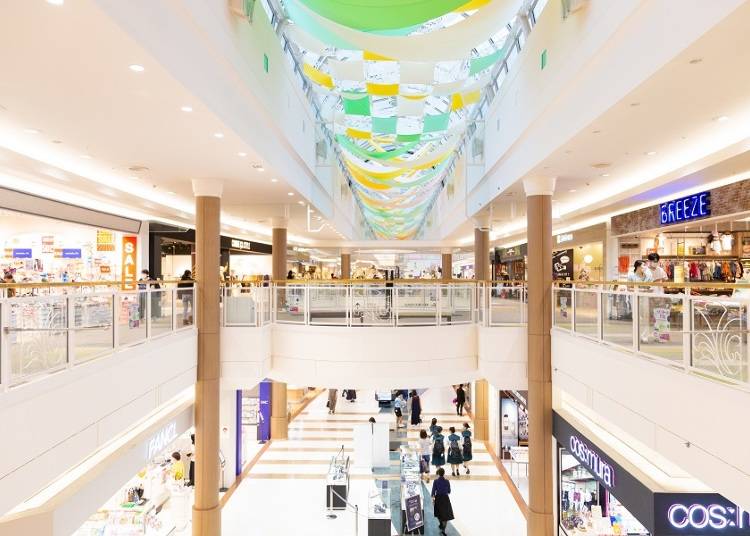
AEON MALL is a popular mall franchise in Japan, and this location has around 170 shops to choose from. When in Japan, check out some Japanese shops like Muji, with its plain, natural aesthetic, or going for the complete opposite – the Sanrio Gift Gate for a cheerful and colorful assault on one’s senses.
The Shisui Premium Outlets have 220 shops, so it is the best opportunity to get discounts on Japanese brands in this area.
-
 AEON MALL Naritaイオンモール成田
AEON MALL Naritaイオンモール成田- Address 24 Uingutsuchiya, Narita, Chiba 286-0029
-
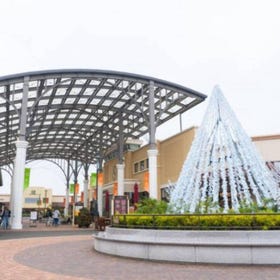 SHISUI PREMIUM OUTLETS®酒々井プレミアム・アウトレット
SHISUI PREMIUM OUTLETS®酒々井プレミアム・アウトレット- Address 2-4-1, Iizumi Shisui-machi, Inba-gun, Chiba, Japan 285-0912
10. Makuhari: Concerts, Japanese Gardens, and Shopping
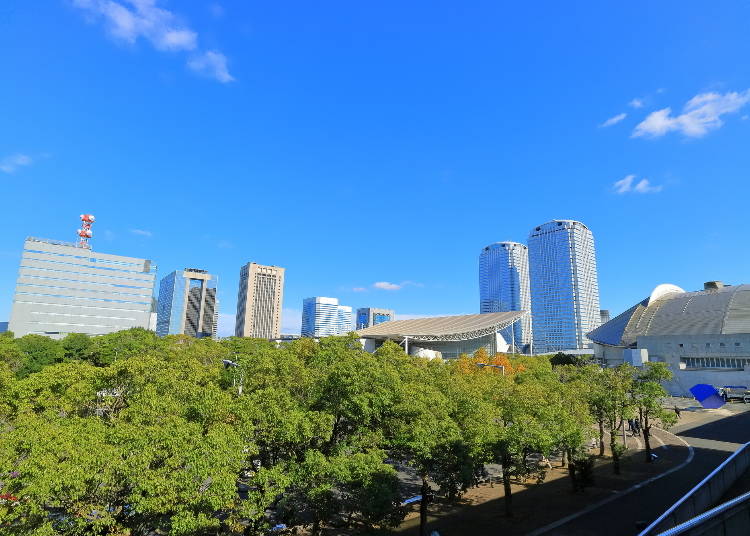
For those looking for a glimpse of the Japanese future, today, the Makuhari community in Chiba Prefecture is a must-visit. With most of the Tokyo area already being densely developed (the population of the greater Tokyo area is 13.96 million!), Makuhari is the answer to creating more space as it was partially built on land reclaimed from the ocean.
Access to Makuhari
From Tokyo Station, take the JR Keiyo Line to Kaihin-Makuhari Station (About 40 min.)
Makuhari Messe and ZOZO Marine Stadium
The main attraction of Makuhari is Makuhari Messe, an undeniably gigantic convention center. The main hall, Makuhari Event Hall, is said to seat up to 9,000 guests! It hosts many technology-centered events like the annual Tokyo Game Show, often has concerts by Japanese artists like Glay and Babymetal, as well as international superstars like Lady Gaga and Mariah Carey. It is an excellent place to check out while in Tokyo – you never know what event will be going on during your visit.
ZOZO Marine Stadium is the home of Chiba’s baseball team, the Chiba Lotte Marines. Apart from baseball, this is the place to catch music festivals and concerts close to Tokyo.
-

-
Address
2-1, Nakase, Mihama-ku, Chiba-shi, Chiba, 261-8550
View Map -
Nearest Station
Kaihin-Makuhari Station (JR Keiyo Line)
5 minutes on foot
- Phone Number 043-296-0001
-
Address
2-1, Nakase, Mihama-ku, Chiba-shi, Chiba, 261-8550
Makuhari Seaside Park
For those who need a break from chaotic city sightseeing, there is Makuhari Seaside Park. This park is so big that is broken up into several blocks, all offering something different. We recommend the C block, which has a traditional Japanese garden, Mihamaen. This exquisitely cultivated garden provides the tranquility that Tokyo often lacks. The Shorai-tei teahouse is an opportunity to sip on Matcha while enjoying Wagashi, the traditional paired sweets which are made of rice, bean paste, and different fruits.
AEON MALL Makuhari, Mitsui Outlet Park
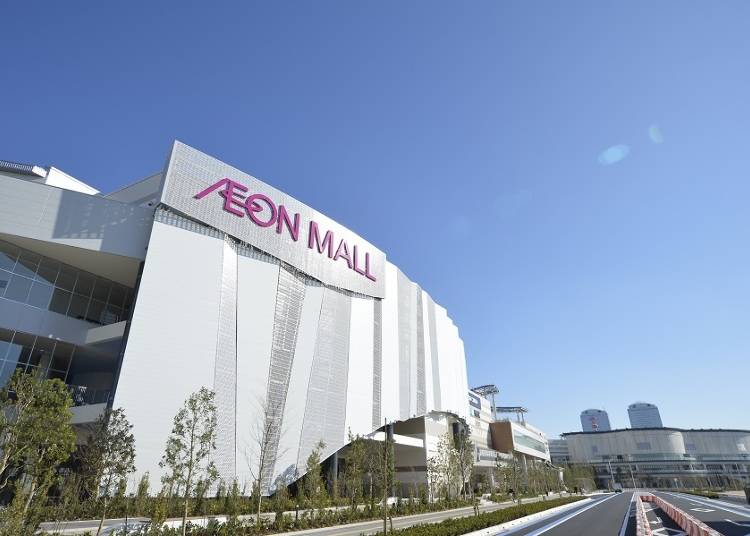
AEON MALL Makuhari Shintoshin is a shopping experience for everyone, with a section focused on family, pets, and even sports and activewear. Visitors can enjoy tax-free shopping in certain stores and there is a prayer room available for Muslim guests. There is plenty of entertainment here as well, like virtual sports gaming attraction HERO’S Playground, namco, which has one of the largest prize corners in the region, or Moff animal café, where you can enjoy hanging out with various animals along with your coffee.

Mitsui Shopping Park is another option, which is an outlet shopping center. Here you’ll find mostly big international brands, but also some Japanese ones like Seiko and Onitsuka Tiger.
-
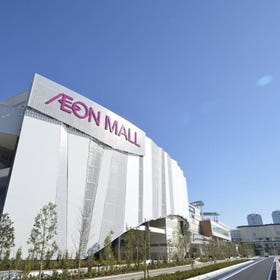 AEON MALL Makuhari Shintoshinイオンモール幕張新都心
AEON MALL Makuhari Shintoshinイオンモール幕張新都心- Address 1-1 Chi, Toyosuna, Mihama-ku, Chiba, Chiba 261-8535
Tokyo Disney Resort and Ikspiari
Just 30 min. away from Makuhari is Tokyo Disney Resort, which features a park only available in Japan, Tokyo DisneySea. The Mermaid Lagoon, based on the Little Mermaid, and the Arabian Coast, inspired by Aladdin are beautiful and unique, and well worth a visit for any Disney fans. Visitors who don’t have time to enter the theme park can enjoy browsing the shops at the nearby shopping mall, Ikspiari, which also has its own Disney store.
-
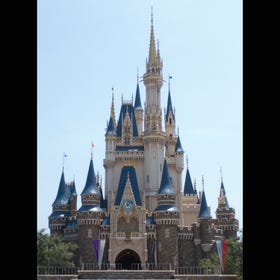
-
Address
1-1, Maihama, Urayasu-shi, Chiba, 279-0031
View Map -
Nearest Station
Maihama Station (JR Keiyo Line)
4 minutes on foot
- Phone Number 0570-00-8632
-
Address
1-1, Maihama, Urayasu-shi, Chiba, 279-0031
-
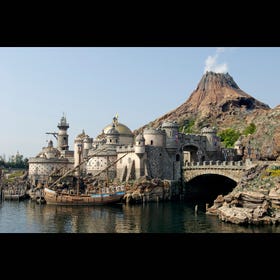
-
Address
1-1, Maihama, Urayasu-shi, Chiba, 279-0031
View Map -
Nearest Station
Maihama Station (JR Keiyo Line)
13 minutes on foot
- Phone Number 0570-00-8632
-
Address
1-1, Maihama, Urayasu-shi, Chiba, 279-0031
A Day Trip Outside Tokyo: Now You’re Set Where to Go, What to Do!
After reading this Tokyo Day Trip article, now you know the TOP 10 attractions near Tokyo. A day trip outside Tokyo will allow you to experience a sense of life that is different from the bustling metropolis! It’s there that you can find a completely different side of Japan, one that’ll leave you with incredible memories, snapshots, and videos, while you can dive deeper into the history of Japan.
The surrounding Tokyo area has a lot to offer in terms of both natural beauty and historical significance. The ancient temples of Nikko, the glimpses of Mt. Fuji from the Kamakura seaside, the hot springs of Hakone, a ski day trip in Karuizawa, the magnificent flower carpets in Chichibu or Hitachi-naka.
Even if your time in Tokyo is short, these meaningful day trip destinations will allow you to attend ancient festivals, walk down the paths of samurai and past heroes, and enjoy a variety of Japanese cuisine – from a dignified cup of matcha to a feast of local seafood. Whether you’re traveling solo or with friends or family, it’s in these areas that you’ll make new memories to cherish!
- Area
- Category
*Prices and options mentioned are subject to change.
*Unless stated otherwise, all prices include tax.
Popular Tours & Activitiess
-
Ad

Walk in the Footsteps of Believers: A 4-Day Pilgrimage Across Goto Islands, Nagasaki Prefecture
by: Yohei Kato
-

Enjoy Japan's Gorgeous Winter Lights! Ride the Romancecar to Shonan no Hoseki Illumination
by: Guest Contributor
-

2025 Autumn Colors Report: Kurobe Gorge Nearing Peak
by: Timothy Sullivan
-

2025 Japan Autumn Color Report: Tokyo's Ginkgo Trees Starting to Glow
by: Timothy Sullivan
-

A Travel Game Changer! Go Hands-Free Between Tokyo and Kyoto with LUGGAGE EXPRESS by JTB and JR Tokai
by: Guest Contributor
-

See Asakusa and Tokyo Skytree® in a New Light at the "Také Akari" Festival (Winter 2025-2026)
by: Guest Contributor
Inspiration for Accommodations
-

Enjoy Mt. Fuji from the Comfort of Your Room! Recommended Ryokan with Mt. Fuji View
-

Stay Near the Cherry Blossoms! Hotels for Cherry Blossom Viewing in Tokyo
-

Family-Friendly Hotels with Free Shuttle to Disneyland: Convenient Access for a Magical Stay
-

Top Ranked Hakone Hotels with Mt. Fuji View: Enjoy Stunning Scenery from Your Private Space
-

Convenient Tokyo Hotels with Airport Shuttle: Ideal for Families and Heavy Luggage
-

Stunning Tokyo Tower View Hotels: Enjoy Spectacular Scenery from Your Private Space
-

Convenient Asakusa Hotels with Kitchens: Ideal for Extended Family Visits
-

Experience Luxury: Hakone's 10 Best Five-Star Accommodations
-

Enjoy Mt. Fuji Autumn Leaves! Top Hotels Near the Popular Autumn Leaves Corridor
-

Experience Hakone Fall Foliage from Your Room with Stunning Views
-

Tokyo Events: Celebrating Earth Day Tokyo 2018
-

Exploring Tokyo Station: 11 Must-Visit Spots Around the Heart of Tokyo
-

Typhoon Safety Guide: What Tourists Need to Know When Visiting Japan
-

Explore Izumi, a charming Japanese city that attracts over 10,000 cranes during the winter
-

Ueno Station Area Guide: Fun Ways to Explore Tokyo's Popular Destination (Area Map & Sightseeing Tips)
-

Spending Wonderful Time Alone in Shibuya - Free Cosmetics and a Hundred-Yen Bus!
- #best ramen tokyo
- #what to buy in ameyoko
- #what to bring to japan
- #new years in tokyo
- #best izakaya shinjuku
- #things to do tokyo
- #japanese nail trends
- #what to do in odaiba
- #onsen tattoo friendly tokyo
- #daiso
- #best sushi ginza
- #japanese convenience store snacks
- #best yakiniku shibuya
- #japanese fashion culture
- #best japanese soft drinks






















